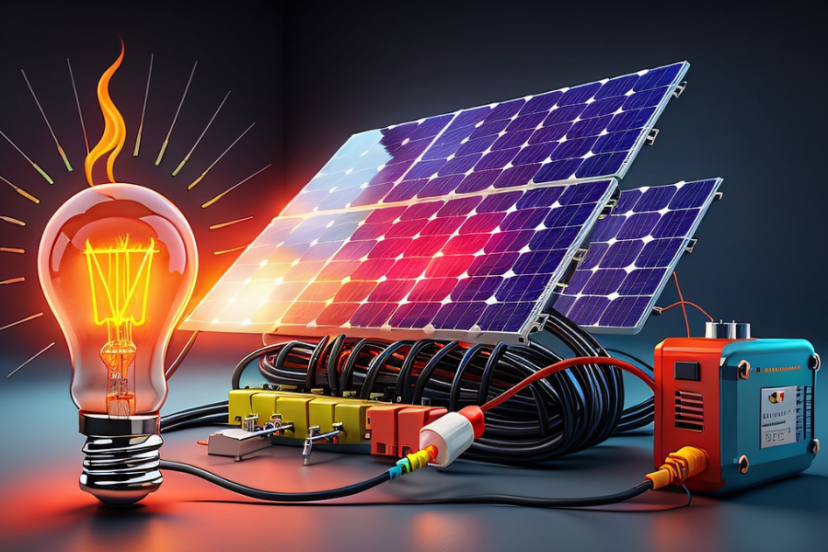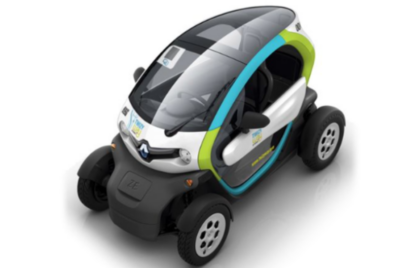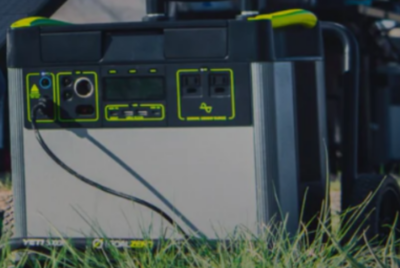Solar Power Battery Bank
Ensuring Reliable Energy Storage
In today’s world, where environmental consciousness and sustainable living are paramount, harnessing the power of the sun through solar panels has become a popular choice. As an electrical engineer and a solar energy enthusiast, I’m often asked about the essential components of a solar power system, and one component that deserves a spotlight is the solar power battery bank.
Solar power has the potential to revolutionize the way we generate and consume electricity. However, the intermittent nature of sunlight means that energy storage solutions are crucial to ensure a continuous power supply. This is where solar power battery banks come into play.
Why a Solar Power Battery Bank Matters
A solar power battery bank is like the heart of a solar energy system. It stores excess energy generated during the day and releases it when the sun isn’t shining, such as at night or during cloudy days. Without an efficient battery bank, you might find yourself relying on grid power more often, missing out on the true benefits of solar energy independence.
Types of Solar Power Battery Banks
Lead-Acid Batteries
Lead-acid batteries have a longstanding history in the realm of energy storage, making them the traditional choice for solar power systems. They have garnered popularity due to their cost-effectiveness and widespread availability.
Here’s a closer look at the key characteristics of lead-acid batteries:
1. Cost-Effective: Lead-acid batteries are relatively affordable, making them an attractive option for those looking to set up a solar power system without breaking the bank.
2. Widely Available: These batteries can be found in many hardware stores and electrical supply shops, which makes them accessible for residential and small-scale solar installations.
However, it’s essential to consider their limitations:
1. Cycle Life: Lead-acid batteries have a limited number of charge-discharge cycles they can go through before their capacity starts to degrade significantly. Typically, they have a cycle life of around 300 to 700 cycles, depending on the specific type (flooded, sealed, or gel cell).
2. Depth of Discharge (DoD): Lead-acid batteries should not be discharged beyond a certain percentage of their capacity, typically around 50%. Going beyond this threshold can significantly reduce their lifespan.
Lithium-Ion Batteries
Lithium-ion batteries, in contrast, represent a more advanced and efficient option for solar power storage.
They offer several advantages that make them an attractive choice for those seeking long-term energy storage solutions:
1. Higher Efficiency: Lithium-ion batteries are known for their higher charge and discharge efficiency compared to lead-acid batteries. This means more of the solar energy you capture gets stored and can be used when needed.
2. Longer Cycle Life: Lithium-ion batteries have a considerably longer cycle life, often exceeding 2,000 cycles or more. This longevity means they can serve you well for many years.
3. Smaller Footprint: Lithium-ion batteries are compact and lightweight compared to their lead-acid counterparts, making them easier to install and integrate into a solar power system.
However, it’s worth noting that lithium-ion batteries come with some trade-offs:
1. Higher Initial Cost: The initial cost of lithium-ion batteries is generally higher than that of lead-acid batteries. This upfront investment may deter some homeowners or businesses.
2. Safety Considerations: Lithium-ion batteries require careful monitoring and management to prevent overcharging or overheating, which can pose safety risks if not handled correctly.
Flow Batteries
Flow batteries for solar power storage gain attention for their unique characteristics, particularly in large-scale solar installations.
Here’s a closer look:
1. Scalability: Flow batteries are known for their scalability, making them an excellent choice for applications where a vast amount of energy storage is required. They can be customized to meet specific energy demands.
2. Extended Power Delivery: Flow batteries have the ability to provide power for extended periods, making them suitable for applications where a consistent and steady power supply is critical.
However, flow batteries also come with their own set of considerations:
1. Complexity: They are more complex to install and maintain compared to traditional battery types, which might require a higher level of expertise.
2. Cost: Flow batteries tend to be more expensive upfront compared to some other battery options, which can be a deterrent for smaller-scale solar projects.
In conclusion, the choice of a solar power battery bank largely depends on your specific needs, budget, and the scale of your solar energy system. Lead-acid batteries are cost-effective but have limitations, while lithium-ion batteries offer efficiency and longevity but come with a higher initial cost. Flow batteries, with their scalability and extended power delivery, are ideal for large-scale installations. It’s crucial to carefully assess these factors to make an informed decision that aligns with your solar energy goals.

Factors to Consider When Choosing a Battery Bank
Capacity and Size
Capacity and size are fundamental factors to consider when selecting a battery bank for your solar power system. Here’s a more detailed explanation:
1. Aligning with Energy Consumption: The capacity of your battery bank should match your energy consumption patterns. It’s crucial to assess how much electricity your household or facility uses daily and during periods of peak demand. A battery bank with a larger capacity can store more energy, providing you with ample backup power when sunlight is scarce.
2. Extended Backup Power: A larger capacity battery bank ensures that you can sustain your energy needs during extended periods of low sunlight. This is particularly important if you live in an area with frequent cloudy days or if you rely heavily on solar power during nighttime hours.
3. Sizing Considerations: The physical size of the battery bank also matters, especially if you have limited space for installation. Smaller, compact battery options may be more suitable for residential settings, while larger battery banks may be necessary for commercial or industrial applications.
Remember that striking the right balance between capacity and size is crucial to optimizing your solar energy system’s performance and ensuring it meets your specific energy demands.
Depth of Discharge (DoD)
Depth of Discharge (DoD) is a critical parameter that determines how much of the battery’s capacity can be utilized before it needs recharging. Here’s a more detailed look:
1. Preserving Battery Life: DoD is a crucial factor in prolonging the lifespan of your battery bank. If you frequently discharge your battery to its maximum capacity (100% DoD), it can significantly reduce the number of charge-discharge cycles the battery can go through before it starts degrading.
2. Setting the Appropriate DoD: Most battery manufacturers recommend not exceeding a certain DoD threshold, typically around 50% for lead-acid batteries and often up to 80% or more for lithium-ion batteries. Staying within these guidelines ensures your battery bank remains reliable over the long term.
3. Balancing Capacity and DoD: When choosing a battery bank, consider the balance between capacity and DoD. A larger capacity battery with a higher DoD percentage may offer more usable energy, but it’s essential to adhere to the manufacturer’s recommendations to avoid premature battery wear.
Cycling Life
Cycling life refers to the number of charge-discharge cycles a battery can undergo before its capacity significantly diminishes. Understanding this factor is crucial for long-term planning and assessing the cost-effectiveness of your solar power system. Here’s a deeper look:
1. Battery Longevity: Different battery types have varying cycle life ratings. Lithium-ion batteries, for instance, often offer a longer cycling life, exceeding 2,000 cycles in many cases. In contrast, lead-acid batteries typically have a lower cycle life, often ranging from 300 to 700 cycles.
2. Calculating Battery Replacement: To estimate the long-term cost of your solar power system, consider the battery’s cycling life. Determine how often you’ll need to replace the battery bank based on your daily energy usage and cycling frequency. Longer cycling life batteries may provide better value over time despite their higher initial cost.
3. Maintenance and Monitoring: Regular maintenance and monitoring of your battery bank’s health can help maximize its cycling life. Implementing proper charging and discharging practices can also contribute to extending the life of your batteries.
In conclusion, capacity, DoD, and cycling life are critical factors to weigh when selecting a battery bank for your solar power system. Balancing these factors appropriately ensures you have a reliable energy storage solution that meets your energy needs, maximizes battery lifespan, and provides a cost-effective long-term investment in clean and sustainable energy.
Installation and Maintenance
Proper installation and regular maintenance are key to ensuring your solar power battery bank operates efficiently. Seek professional help for installation, and follow maintenance guidelines provided by the manufacturer.
Installation
Proper installation of your solar power battery bank is the foundation of a reliable and efficient solar energy system. Here are some key considerations:
1. Professional Assistance: While some DIY enthusiasts may be tempted to install their battery bank, it is highly advisable to seek professional help. Professional installers have the expertise and experience to ensure the safe and efficient integration of your battery bank into your solar power system.
2. Site Assessment: Before installation, a thorough site assessment is essential. Professionals will evaluate factors such as the location, orientation, and structural integrity of the installation site. This assessment helps optimize the battery bank’s performance and ensures it meets safety standards.
3. Electrical Compatibility: Ensuring that the battery bank is electrically compatible with your solar panels, inverters, and other components is critical. Professionals can help select the right components and ensure proper wiring and connections.
4. Safety Measures: Safety should always be a top priority. Professionals are well-versed in safety protocols, including proper handling of batteries, electrical connections, and compliance with local building codes.
5. Testing and Commissioning: After installation, comprehensive testing and commissioning procedures should be conducted. This ensures that the battery bank is functioning as intended and can seamlessly integrate with your solar power system.
Maintenance
Regular maintenance is crucial to maximize the lifespan and efficiency of your solar power battery bank. Here’s a closer look at the maintenance aspects:
1. Manufacturer’s Guidelines: Always adhere to the maintenance guidelines provided by the battery manufacturer. These guidelines include recommendations for charging and discharging practices, temperature management, and routine inspections.
2. Visual Inspections: Periodically inspect the battery bank for physical damage, leaks, or signs of corrosion. Visual inspections can help identify potential issues before they escalate.
3. Temperature Control: Maintaining an optimal temperature range is essential for battery longevity. If possible, install the battery bank in a cool, well-ventilated area to prevent overheating. Some battery banks may come with integrated temperature control systems.
4. Charging and Discharging: Follow the recommended charging and discharging practices to prevent overcharging or over-discharging, which can damage the battery. Charge the battery bank according to the manufacturer’s specifications and avoid excessive DoD (Depth of Discharge).
5. Battery Monitoring Systems: Consider investing in battery monitoring systems that provide real-time data on the status and performance of your battery bank. These systems can alert you to any anomalies and help you make informed decisions regarding maintenance.
6. Cleaning and Terminals: Keep the battery bank and its terminals clean and free from dirt, dust, and debris. Corroded terminals can hinder the battery’s performance and connectivity.
7. Regular Testing: Periodically conduct capacity and performance tests to ensure that the battery bank is operating at its optimum capacity. This can help detect any degradation in performance and allow for timely maintenance or replacement.
By following these installation and maintenance practices, you can ensure that your solar power battery bank operates efficiently, delivers reliable backup power, and has an extended lifespan. Additionally, professional installation and adherence to manufacturer guidelines will contribute to the safety and overall performance of your solar energy system, giving you peace of mind as you harness clean and sustainable energy.
Efficiency and Charging
Efficiency matters when converting solar energy to electricity and storing it in the battery bank. Higher efficiency means less energy loss during the process. Additionally, consider the charging methods compatible with your battery bank.
Efficiency in Energy Conversion and Storage
Efficiency is a crucial factor in a solar power system, encompassing the entire process of converting solar energy into electricity and storing it in the battery bank. Here’s why it matters:
1. Maximizing Energy Harvest: Solar panels capture sunlight and convert it into electrical energy. Higher efficiency panels can convert a greater portion of the incoming sunlight into usable electricity. This means you can generate more electricity for storage in your battery bank, maximizing the energy harvested from the sun.
2. Reducing Energy Loss: During the energy conversion and storage process, some energy is lost as heat. This is particularly relevant in components like inverters and charge controllers. Opting for high-efficiency components can significantly reduce these losses, ensuring that a larger portion of the solar energy gets stored in your battery bank.
3. Optimizing Battery Efficiency: Battery efficiency plays a critical role in the overall performance of your solar power system. Efficient batteries can store and discharge energy with minimal losses, which is especially important for maintaining a consistent power supply during periods of low sunlight.
4. Long-Term Cost Savings: Higher efficiency means you get more out of your solar power system, ultimately leading to long-term cost savings. You’ll need fewer solar panels, inverters, and batteries to meet your energy needs, which can offset the initial investment.
Charging Methods Compatibility
Charging methods compatibility refers to the compatibility of your battery bank with the charging methods employed in your solar power system. Here’s why it’s important:
1. Optimal Charging: Different types of battery banks may have specific requirements when it comes to charging voltage, current, and charging profiles. It’s crucial to ensure that the charging methods employed in your solar system align with the manufacturer’s recommendations for your battery bank. This ensures that your batteries are charged optimally and efficiently.
2. Overcharging Prevention: Overcharging a battery can lead to damage, reduced lifespan, and safety risks. Employing compatible charging methods and charge controllers that can regulate the charging process is essential to prevent overcharging and maintain the integrity of your battery bank.
3. Balancing Multiple Batteries: If your solar power system involves multiple batteries connected in parallel or series, it’s essential to consider how charging methods will balance the charge among these batteries. Proper charge distribution ensures that each battery within the bank is charged uniformly and efficiently.
4. Charge Storage Efficiency: Compatible charging methods also influence the efficiency of energy storage. Ensuring that the battery bank receives the right amount of energy at the right voltage and current levels optimizes its charge storage efficiency.
In conclusion, efficiency and charging methods compatibility play critical roles in the overall effectiveness of your solar power system and battery bank. Higher efficiency at every stage of energy conversion and storage minimizes energy losses and maximizes the utilization of solar power. Additionally, ensuring that your charging methods align with the requirements of your battery bank is essential for its long-term performance, safety, and efficiency. When these factors are considered and implemented correctly, your solar power system will provide reliable and cost-effective access to clean and sustainable energy.
Economic Considerations
While lithium-ion batteries may have a higher upfront cost, they often prove more cost-effective over their lifespan due to their longevity and efficiency. Calculate the total cost of ownership before making a decision.
Environmental Impact
Opting for environmentally friendly battery technologies can contribute to reducing your carbon footprint. Explore options with minimal toxic materials and high recyclability.
Environmental Impact of Battery Technologies
The choice of battery technology for your solar power system can have a significant impact on the environment. Here’s why it matters:
1. Reducing Carbon Footprint: One of the primary objectives of adopting solar power is to reduce your carbon footprint by generating clean and renewable energy. However, the environmental benefits of solar energy can be offset if the battery bank uses technologies that are resource-intensive or environmentally harmful.
2. Toxic Materials: Some battery technologies, such as lead-acid batteries, contain toxic materials like lead and sulfuric acid. Improper disposal or recycling of these batteries can result in soil and water contamination, posing health risks to both humans and ecosystems.
3. Resource Depletion: The production of certain battery materials, such as cobalt and lithium for lithium-ion batteries, can have adverse environmental impacts. Over-mining or unethical sourcing practices can lead to habitat destruction and resource depletion.
4. Recyclability: The ability to recycle and repurpose batteries at the end of their life cycle is essential for minimizing waste and environmental impact. Batteries that are not easily recyclable contribute to electronic waste (e-waste) concerns.
Environmentally Friendly Battery Options
When considering the environmental impact of your solar power battery bank, it’s essential to explore options that prioritize sustainability and eco-friendliness:
1. Lithium Iron Phosphate (LiFePO4) Batteries: LiFePO4 batteries are known for their minimal environmental impact. They contain no toxic heavy metals and have a long lifespan, reducing the frequency of replacements and waste generation.
2. Nickel-Iron (NiFe) Batteries: NiFe batteries are renowned for their durability and recyclability. They have a long service life and do not contain harmful materials like lead or cadmium.
3. Flow Batteries: Some flow battery chemistries, such as vanadium flow batteries, have a relatively low environmental impact. They are known for their long cycling life and recyclability.
4. Recycling Programs: Consider battery manufacturers or suppliers that offer recycling programs for their products. These programs ensure that old batteries are properly disposed of and recycled, reducing their environmental impact.
5. Sustainable Sourcing: Inquire about the sourcing practices of battery manufacturers. Opt for companies that adhere to ethical and sustainable sourcing of raw materials to minimize habitat destruction and resource depletion.
6. Local Regulations: Be aware of and comply with local regulations regarding the disposal and recycling of batteries. Many regions have specific guidelines for the responsible disposal of batteries to minimize environmental harm.
By choosing battery technologies that are environmentally friendly, contain minimal toxic materials, and prioritize recyclability, you can align your solar power system with your environmental values. This not only reduces your carbon footprint but also contributes to a cleaner and more sustainable energy future. Additionally, supporting eco-conscious battery manufacturers encourages responsible practices in the industry and promotes the development of greener energy storage solutions.
The Future of Solar Power Battery Banks
As technology advances, we can expect even more efficient and sustainable solar power battery banks to emerge. Keep an eye on innovations in this field for future upgrades to your solar energy system.
Conclusion
A solar power battery bank is a vital component of any solar energy system. Choosing the right type, size, and technology can make a significant difference in the reliability and effectiveness of your solar power setup. By considering all the factors discussed, you can ensure your solar power battery bank empowers you to harness the full potential of clean and sustainable energy.
FAQs
1. How long do solar power battery banks last?
Solar power battery bank lifespans vary but typically range from 5 to 20 years, depending on the type and usage.
2. Can I install a solar power battery bank myself?
While it’s possible for DIY enthusiasts, it’s recommended to hire a professional for safe and efficient installation.
3. What is the ideal location for a solar power battery bank?
Battery banks should be installed in a cool, well-ventilated area away from direct sunlight and extreme temperatures.
4. Are lithium-ion batteries worth the higher initial cost?
Yes, due to their longer lifespan and higher efficiency, lithium-ion batteries often provide better value over time.
5. Can I connect multiple solar power battery banks together?
Yes, you can connect multiple battery banks to increase your storage capacity, but proper configuration and maintenance are essential for optimal performance.




